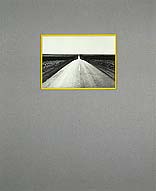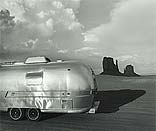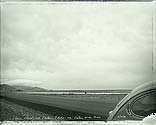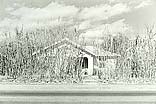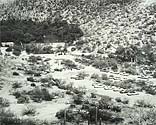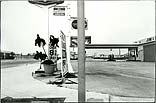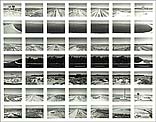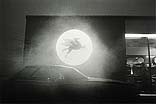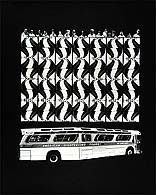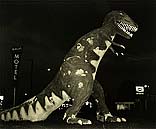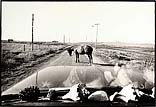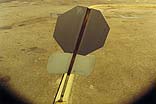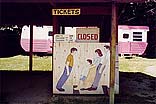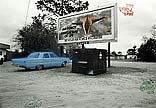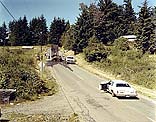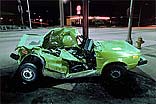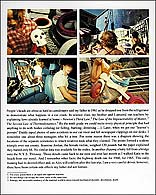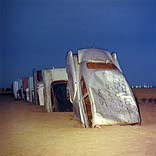 Roger
Minick, Airstream
at Monument Valley, Arizona, 1979, black-and-white silver
print Roger
Minick, Airstream
at Monument Valley, Arizona, 1979, black-and-white silver
print
 Mark
Klett, Storm Clouds over Eastern Idaho, near Craters
of the Moon, 1980, black-and-white silver print Mark
Klett, Storm Clouds over Eastern Idaho, near Craters
of the Moon, 1980, black-and-white silver print
 Henry
Wessel, Jr., Tucson, Arizona, 1974, black-and-white silver print Henry
Wessel, Jr., Tucson, Arizona, 1974, black-and-white silver print
 Harold
Jones, Baptism, Sabino Canyon, Tucson Arizona,
1976, black-and-white silver print Harold
Jones, Baptism, Sabino Canyon, Tucson Arizona,
1976, black-and-white silver print
 Frank
Gohlke,
Aerial View, Tulsa, Oklahoma, 1981, from Tulsa
International Airport mural commission, black-and-white silver
print Frank
Gohlke,
Aerial View, Tulsa, Oklahoma, 1981, from Tulsa
International Airport mural commission, black-and-white silver
print
 Tod
Papageorge, Burbank, California, 1973, black-and-white silver print Tod
Papageorge, Burbank, California, 1973, black-and-white silver print
 Jim
Alinder, A Joy Forever, Roadside, Florida, 1974, photographed at the side
of an inland two-lane blacktop between Key West and Disney World,
black-and-white silver print Jim
Alinder, A Joy Forever, Roadside, Florida, 1974, photographed at the side
of an inland two-lane blacktop between Key West and Disney World,
black-and-white silver print
 Nathan
Lyons, untitled, 1968, Vancouver BC and 1969, Los Angeles,
California, from his book Notations in Passing, black-and-white
silver prints Nathan
Lyons, untitled, 1968, Vancouver BC and 1969, Los Angeles,
California, from his book Notations in Passing, black-and-white
silver prints
 Robbert
Flick, East of Lancaster, along Highway
14, California, (SV044/81), 1981,
from "Sequential Views" series, black-and-white silver print Robbert
Flick, East of Lancaster, along Highway
14, California, (SV044/81), 1981,
from "Sequential Views" series, black-and-white silver print
 Elaine
Mayes, Pegasus, 1972, photographed on
the New York Thruway, I-87, black-and-white silver print Elaine
Mayes, Pegasus, 1972, photographed on
the New York Thruway, I-87, black-and-white silver print
 Barbara
Crane, Bus People, 1975, from Baxter/Travenol
Laboratories mural commission, printed from negatives made in the vicinity of Chicago,
Illinois, black-and-white silver print Barbara
Crane, Bus People, 1975, from Baxter/Travenol
Laboratories mural commission, printed from negatives made in the vicinity of Chicago,
Illinois, black-and-white silver print
 Steve
Fitch, Dinosaur, Highway 40, Vernal, Utah, 1974,
from his book Diesels and
Dinosuars, sepia-toned silver print Steve
Fitch, Dinosaur, Highway 40, Vernal, Utah, 1974,
from his book Diesels and
Dinosuars, sepia-toned silver print
 Michael
Becotte, untitled, 1974, from his book Space
Capsule, photographed on the northern East Coast, sepia and gold-toned silver
print Michael
Becotte, untitled, 1974, from his book Space
Capsule, photographed on the northern East Coast, sepia and gold-toned silver
print
 Michael
Bishop, untitled, 1974, (74-1107), photographed at the side of U.S. 1,
Los Angeles, California, Ektacolor print Michael
Bishop, untitled, 1974, (74-1107), photographed at the side of U.S. 1,
Los Angeles, California, Ektacolor print
 Ken
Brown, Pink Trailer Tilt, 1976, near Cherokee,
North Carolina Ken
Brown, Pink Trailer Tilt, 1976, near Cherokee,
North Carolina ,
Ektacolor print ,
Ektacolor print
 Robert
W. Fichter, Air Power, 1979, Tallahassee, Florida,
black-and-white silver print with air-brushed color and rubber
stamps Robert
W. Fichter, Air Power, 1979, Tallahassee, Florida,
black-and-white silver print with air-brushed color and rubber
stamps
 Joel
Sternfeld, Exhausted Renegade Elephant, Woodland,
Washington, 1979, Ektacolor
print Joel
Sternfeld, Exhausted Renegade Elephant, Woodland,
Washington, 1979, Ektacolor
print
 Victor
Landweber, S.N. Ward and Son Mobil Service, Pasadena,
California, 1978, photographed
at the side of Highway 11, Cibachrome print Victor
Landweber, S.N. Ward and Son Mobil Service, Pasadena,
California, 1978, photographed
at the side of Highway 11, Cibachrome print
 Barbara
Jo Revelle, untitled, 1981, Chicago, Illinois and Los Angeles, California,
Ektacolor print Barbara
Jo Revelle, untitled, 1981, Chicago, Illinois and Los Angeles, California,
Ektacolor print
 Robert
A. Widdicombe, Cadillac Ranch, Amarillo, Texas, 1979, photographed
at the side of U.S. 66. Ektacolor print Robert
A. Widdicombe, Cadillac Ranch, Amarillo, Texas, 1979, photographed
at the side of U.S. 66. Ektacolor print
|
